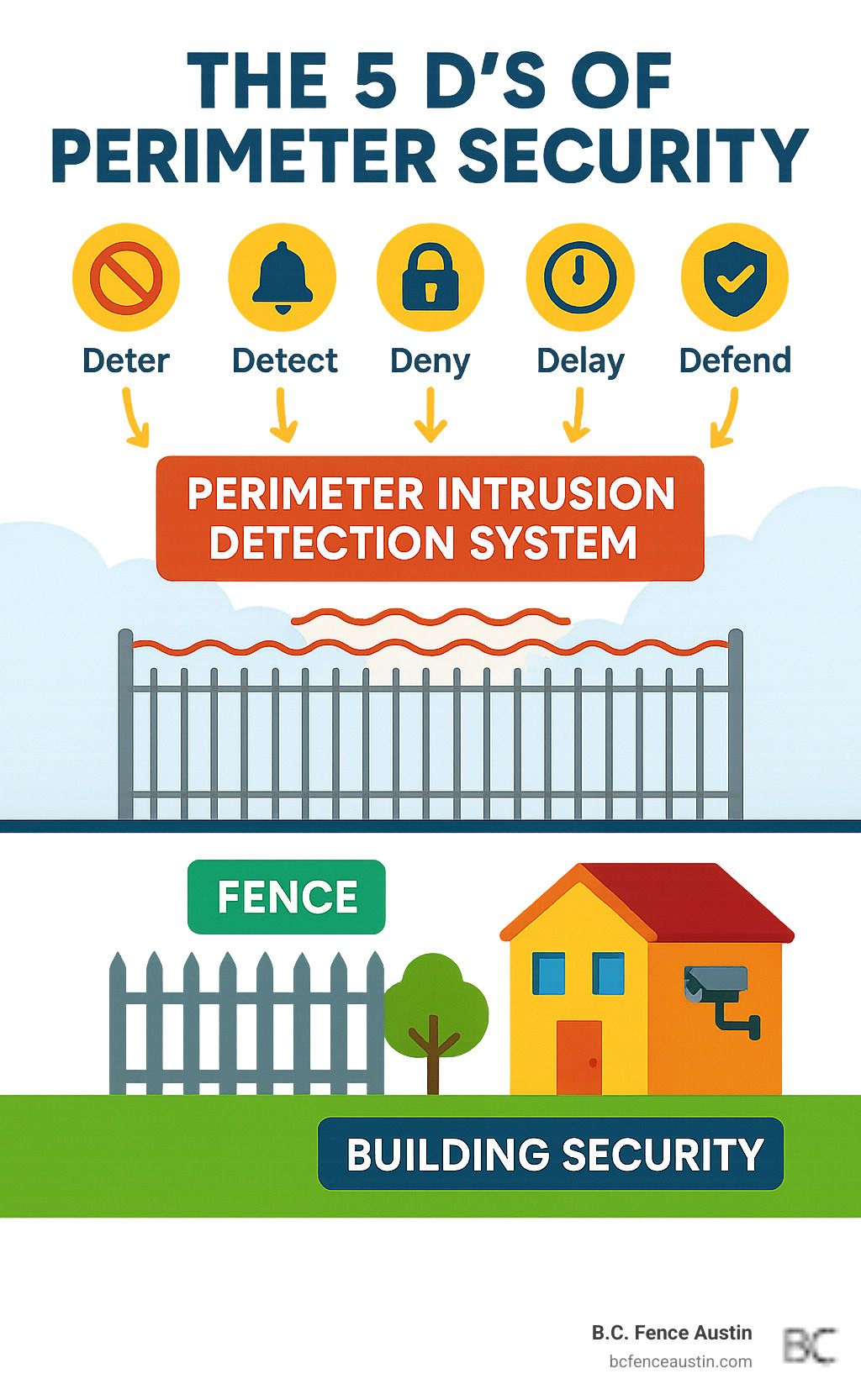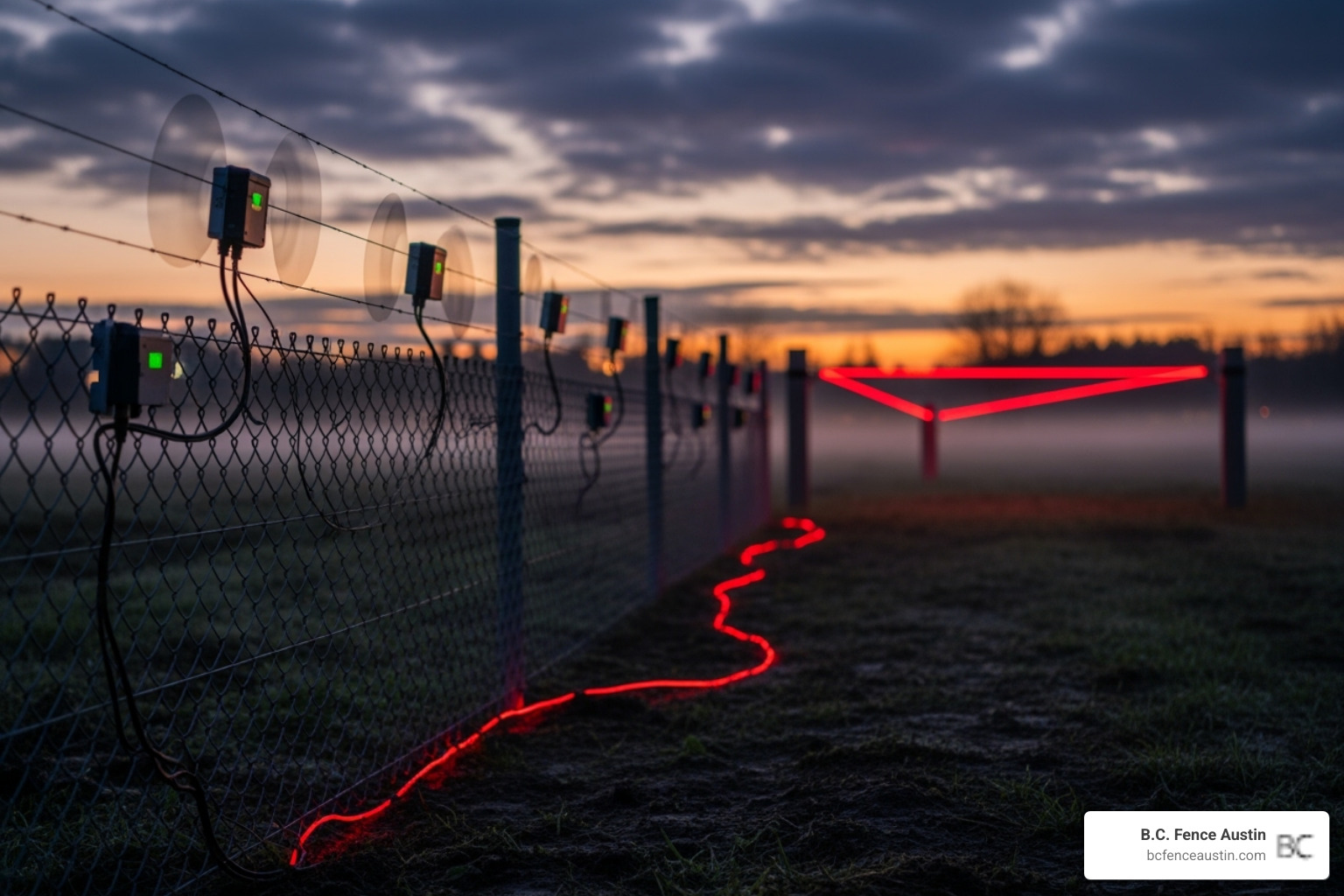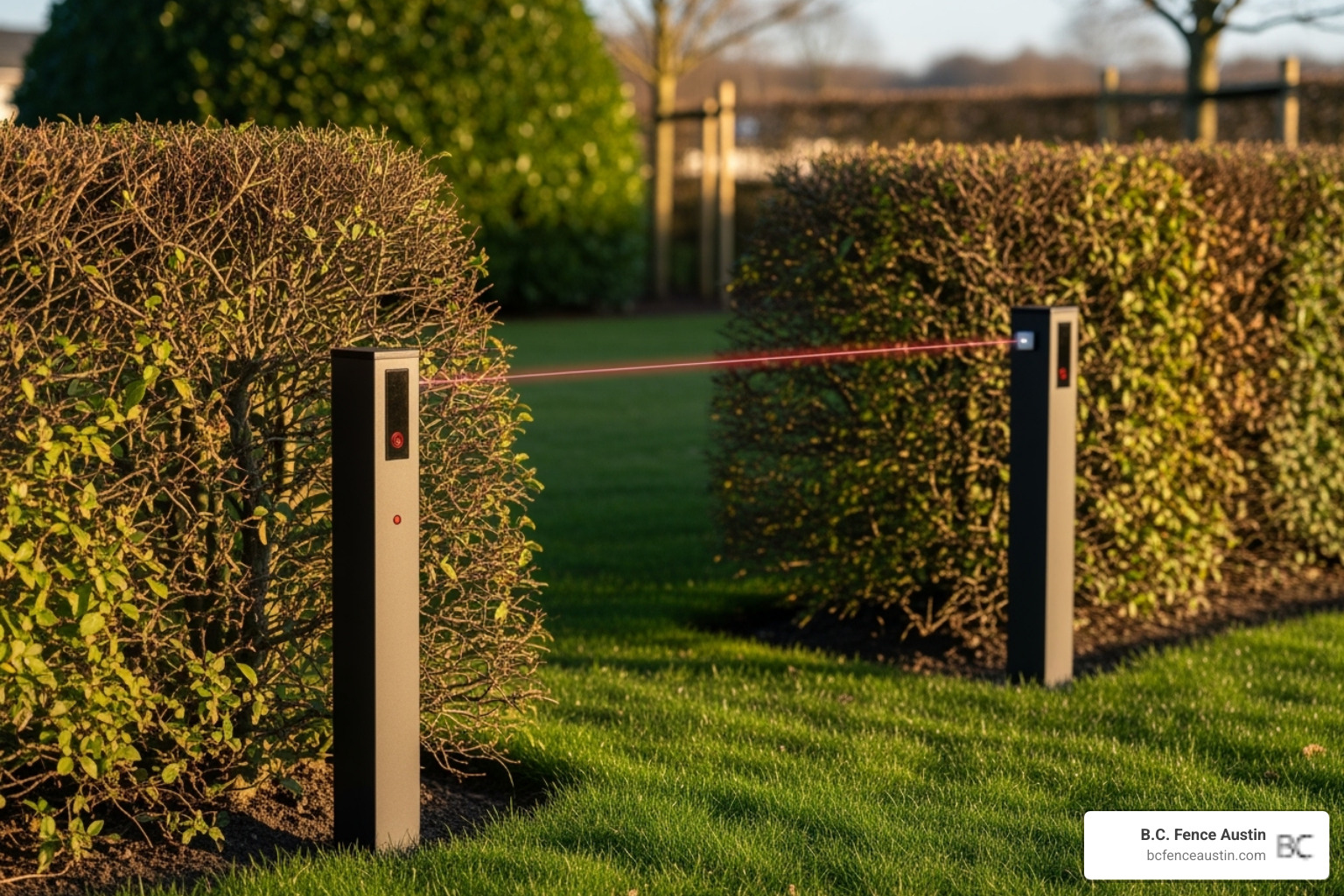Why Perimeter Intrusion Detection Systems Are Your First Line of Defense

Perimeter intrusion detection systems (PIDS) are security solutions that monitor and detect unauthorized access attempts along a property’s physical boundaries. They act as an early warning network, alerting you to threats before intruders reach your building or home.
Quick Overview: What You Need to Know About PIDS
- Purpose: Detect intruders at property boundaries, not inside buildings.
- Primary Goal: Provide early warning and increase response time.
- Key Technologies: Fence sensors, buried cables, infrared beams, and video analytics.
- Main Benefit: Acts as a “technology force multiplier” for security personnel.
While fences are a great foundation, a determined intruder can often climb, cut, or bypass them. A PIDS transforms your fence from a simple barrier into an intelligent early warning system. Modern technology has evolved beyond basic motion sensors; today’s systems can distinguish between animals and people, identify the vibration of a wire being cut, and even track intruders with radar up to 1,500 meters away.
PIDS fulfills the critical “detect” function in the 5 D’s of perimeter security: Deter, Detect, Deny, Delay, and Defend. While a fence denies and delays, the detection from a PIDS gives you precious time to assess and respond. For any property owner, PIDS represents the evolution from passive barriers to active, 24/7 protection without fatigue or distraction.

Perimeter intrusion detection systems terminology:
Understanding PIDS Technologies: From Fences to Fields
When exploring perimeter intrusion detection systems, you’ll find a family of smart technologies, each designed to catch intruders before they get too close. These systems can be grouped into three main types: those that attach to existing barriers, those hidden underground, and those that create invisible walls in mid-air. Each has its strengths, and understanding them helps in making the right choice. The Department of Homeland Security offers A helpful guide to PIDS from the Department of Homeland Security for a technical breakdown.

Barrier-Mounted and Fence-Mounted Sensors
These sensors attach directly to your fence, turning a physical barrier into a sensitive early warning system. They are designed to feel every shake, vibration, and disturbance associated with an intrusion attempt.
- Vibration and Microphonic Sensors: These systems use sensitive cables or accelerometers to detect vibrations from climbing or cutting. Microphonic cables go a step further by analyzing the specific sound patterns of tampering.
- Fiber-Optic Sensors: Pulses of light are sent through fiber-optic cables on the fence. A disturbance changes how the light travels, triggering a highly accurate alert that can often identify the type of intrusion.
- Taut-Wire Systems: This traditional method uses spring-loaded wires that trigger an alarm if they are spread or cut.
The effectiveness of these sensors depends on a solid fence. A wobbly fence can cause false alarms, while a sturdy one provides a stable platform. Our Security Fences provide the perfect foundation for these systems, creating a comprehensive Fence Perimeter Protection solution.
Ground-Based and Buried Sensors
For covert security, ground-based sensors create completely invisible detection zones. They are ideal for catching intruders who avoid the fence line.
- Buried Cable Sensors: These cables, including ported coaxial and pressure-sensitive types, are buried just below the surface. They create an invisible electromagnetic field or detect pressure changes from footsteps or vehicles.
- Seismic and Acoustic Sensors: Buried seismic sensors detect the unique ground vibrations from footsteps or vehicles, while acoustic sensors listen for sounds like digging or cutting. Magnetic sensors can detect large metal objects.
The main advantage of buried perimeter intrusion detection systems is their invisibility and resistance to tampering. While installation is more involved and depends on factors like soil conditions, they offer best covert protection.
Free-Standing and Virtual Barrier Sensors
These systems create invisible fences in open areas, at gates, or where a physical barrier isn’t practical.

- Active Infrared (AIR) Sensors: A transmitter sends an invisible infrared beam to a receiver. If the beam is broken, an alarm is triggered. These can cover long distances but require a clear line of sight.
- Passive Infrared (PIR) Sensors: These detect changes in heat signatures, such as a person moving into their coverage area. They are excellent for monitoring specific chokepoints.
- Microwave Barriers: Using microwave energy, these create volumetric detection zones that can detect movement, direction, and speed. They are robust but also require clear paths.
For more technical details, you can explore More on PIDS technology.
Advanced Detection: Video Analytics and Ground Radar
The newest perimeter intrusion detection systems use AI and advanced radar to not just detect, but understand what they are seeing.
- Video Analytics: AI-powered cameras are transformed into intelligent observers that can distinguish between humans, vehicles, and animals. This dramatically reduces false alarms and allows for automated verification and tracking of threats.
- Ground Radar Systems: These systems provide continuous coverage regardless of light or weather by emitting radio waves to detect and track movement. They have an impressive range, detecting intruders up to 1,500 meters away, even behind some obstacles.
The Strategic Role of Perimeter Intrusion Detection Systems in Security
Perimeter intrusion detection systems provide the one resource you can’t get back: time. Detecting a threat at your property’s edge, rather than your front door, gives you precious minutes to assess and respond. This transforms your security from reactive to proactive. Understanding The Role of Commercial Fencing in Crime Prevention is crucial, as your fence is the foundation that makes these smart systems effective.
The Core Functions and Benefits of PIDS
Perimeter intrusion detection systems are game-changers for property security. Their primary benefits include:
- Early Threat Detection: Know someone is trying to break in while they’re still outside, giving you a critical head start.
- Deterrence: Visible sensors and a reputation as a hard target discourage potential intruders.
- 24/7 Monitoring: Automated sensors work around the clock without fatigue or distraction.
- Improved Efficiency and Reduced Costs: PIDS acts as a force multiplier, allowing security personnel to focus on responding to verified threats instead of constant patrols, which reduces operational costs over time.
These systems are trusted to protect a wide range of facilities, including airports, critical infrastructure, military bases, correctional facilities, data centers, industrial plants, and high-end residential estates.
How PIDS Creates a Layered and Integrated Defense
The real power of PIDS is realized when it’s part of an integrated security system. A robust physical barrier, like a well-maintained fence, provides the foundation. The PIDS adds the next layer, turning that fence into an active warning network. When integrated with other systems, its effectiveness multiplies:
- CCTV Integration: When a sensor is triggered, cameras automatically pan, tilt, and zoom to the exact spot for instant visual verification.
- Access Control Systems: Gates and doors can lock down automatically when an intrusion is detected nearby.
- Alarm Management Platforms: All alerts, video feeds, and controls are consolidated into a single command center for coordinated response.
This hybrid approach dramatically reduces false alarms and improves real threat detection. It’s a key reason Why You Should Invest in Security Fencing—a smart fence is far more than just a physical barrier.
Automated Responses: What Happens When an Intrusion is Detected?
Modern perimeter intrusion detection systems follow a rapid “Detect-Assess-Respond” protocol. Once a genuine threat is confirmed, a coordinated series of automated actions can occur simultaneously:
- Alerts and Notifications: Real-time alerts are sent to security personnel and emergency responders, providing details on the threat’s location and nature.
- Deterrent Activation: Sirens, high-intensity floodlights, and pre-recorded warnings can activate to startle intruders and encourage them to flee.
- Automated Tracking and Recording: All cameras in the area begin recording, while PTZ (pan-tilt-zoom) cameras can automatically track the intruder’s movements.
- Access Point Lockdown: Nearby gates and doors can be automatically secured to contain the threat and prevent escape.
This coordinated response happens in seconds, creating a system that can actively defend your property.
Key Considerations for PIDS Design and Implementation
Choosing and implementing the right perimeter intrusion detection systems requires a custom approach custom to your property. There is no one-size-fits-all solution; a system for a flat industrial lot will differ from one for a hilly residential property with dense trees. Smart planning is essential to address the unique challenges of your environment.

How to choose the right perimeter intrusion detection systems
Selecting an effective PIDS begins with a comprehensive site survey to understand your property’s specific needs. Key factors to consider include:
- Site and Threat Analysis: What are your specific security risks? Identifying vulnerable points, access routes, and potential threats informs the entire design.
- Terrain and Environment: The landscape—whether it’s flat, hilly, or heavily vegetated—dictates which sensor technologies will perform best. Environmental factors like Austin’s weather patterns and local wildlife must also be considered.
- Perimeter Complexity: A simple, rectangular perimeter may be suited for infrared beams, while a complex boundary with many corners and gates may require a mix of sensor types.
- Integration: Your new PIDS must integrate seamlessly with existing security systems like cameras, alarms, and access control.
Understanding How to Choose the Right Commercial Fencing for Your Industry helps match the detection system to your physical barriers.
Installation, Maintenance, and Overcoming Challenges
Even the best perimeter intrusion detection systems are only as good as their installation and maintenance. Professional installation is essential for proper calibration and placement. This includes creating “sterile zones”—clear areas around sensors free of vegetation or debris—and ensuring proper Fence Post Reinforcement for fence-mounted hardware. Routine maintenance, including cleaning sensors and testing power systems, is critical for long-term reliability.
The primary challenge for any PIDS is managing false alarms. The industry standard for an acceptable Nuisance Alarm Rate (NAR) is about five alarms per day per kilometer in good weather. Modern technology offers powerful tools to minimize these nuisance alerts:
- Advanced Filtering: Precise sensor calibration, advanced signal processing, and AI-powered filtering help systems distinguish between real threats and harmless environmental disturbances.
- Dual-Technology Sensors: These units combine two different detection methods (e.g., microwave and infrared) and only trigger an alarm when both detect an intrusion, dramatically reducing false positives.
- Video Verification: Integrating CCTV allows security personnel to instantly view the area where an alarm was triggered, providing immediate visual confirmation of a threat and preventing unnecessary responses.
Frequently Asked Questions about PIDS
As we install fences in Austin, Cedar Park, Leander, and Georgetown, we receive many questions about perimeter intrusion detection systems. Here are the most common questions with straightforward answers.
What is the main difference between a PIDS and a standard building alarm?
The simplest way to think about it is location and timing. A standard building alarm alerts you after someone has already breached your building’s defenses and is inside.
A PIDS is an early warning system that detects intruders at the edge of your property—often at the fence line—before they get near the building. This provides crucial extra time to assess the situation and respond before a break-in occurs.
Can perimeter intrusion detection systems be used for residential properties?
Yes, absolutely. While once common only for high-security sites, PIDS technology is now increasingly accessible and used for residential properties. For homes, systems are often more subtle. Popular options include:
- Active infrared beams that create invisible tripwires across a yard.
- Smart cameras with video analytics that can distinguish people from animals.
- Fence vibration sensors that attach discreetly to an existing fence to detect climbing or cutting.
The key is choosing a system scaled to your property, whether it’s a large estate or a smaller home needing an extra layer of security.
How effective are PIDS in bad weather like rain, snow, or fog?
Effectiveness varies by technology. Ground-based sensors, like buried cables or seismic detectors, are the most weather-resistant because they are underground and unaffected by surface conditions.
Infrared and microwave systems, which operate above ground, can be challenged by heavy rain, dense fog, or snow, as these conditions can interfere with their beams.
However, modern perimeter intrusion detection systems are designed to mitigate these issues. Many use advanced signal processing to filter out weather-related disturbances. Dual-technology sensors, which require two different technologies to confirm a threat, are also highly effective at reducing false alarms caused by weather. Finally, adjustable sensitivity settings allow systems to be fine-tuned for local climate conditions.
Conclusion: Fortify Your Perimeter with an Integrated Solution
Perimeter intrusion detection systems are smart, practical solutions that shift your property’s security from reactive to proactive. Instead of finding a break-in after the fact, you are alerted the moment an attempt is made. The true value of modern PIDS lies in how they integrate with your physical barriers, turning a simple security fence into an intelligent, responsive defense network.
We’ve seen how different technologies—from fence-mounted vibration sensors to buried cables and advanced radar—work to protect properties. These systems provide the invaluable asset of time: time to assess a threat, time to call for help, and time to make smart decisions. When your sensors, cameras, and access controls work together, you have a comprehensive system that protects your property around the clock.
At B.C. Fence Austin, we understand that a strong physical barrier is the essential starting point. Our Security Fence Installation provides the robust foundation required for these advanced systems to perform at their peak. Without a quality fence, even the best sensors are compromised.
Your property deserves protection that is as sophisticated as the threats it faces. Whether you are securing a home in Cedar Park, a business in Georgetown, or an industrial site in the Austin area, an integrated perimeter security solution offers true peace of mind.
Ready to improve your property’s safety? Contact us to learn more about securing your property’s perimeter and find how quality fencing and intelligent detection can transform your security.
